Shinto symbols
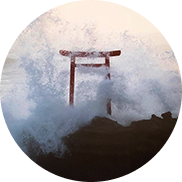
Torii
Perhaps the most recognizable symbols of Shintoism are the majestic gates that mark the entrance to Shinto shrines. Made of wood or stone, the two-post gateways are known as “torii” and show the boundaries in which a kami lives. The act of passing through a torii is seen as a form of purification, which is very important when visiting a shrine.
In Japan, the color red is representative of the sun and life, and it is also said to ward off bad omens and disasters. Once again, by passing through these (mostly) red gates, visitors are cleansed of any bad energy, ensuring that only good energy will be brought to the Kami that resides inside.
There are a variety of torii made of unlacquered wood, stone (usually white or grey in color), and even metal. While there are a great number of color variations, there is an even greater number of shapes (somewhere around 60 varieties). The two most common kinds, however, are “myojin” and “shinmei” torii. Myojin torii are curved upwards at their ends and have a crossbeam that extends past the posts. Shinmei torii, however, have a straight top and a crossbeam that ends at each post.
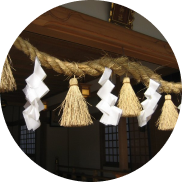
Shimenawa
Shimenawa are ropes often adorned with white zig-zag-shaped pieces and natural tassels. They are often seen hanging from toriis, wrapped around sacred trees and rocks or even fastened around the waist of some sumo wrestlers. These special trees, rocks, and “yokozuna” (sumo grand champs) are known as “yorishiro,” meaning something that attracts gods or has a god living within. They are typically used to mark the boundaries of sacred space and are said to ward off evil spirits.

Shide
The zig-zag white papers, often hanging from the aforementioned shimenawa. These items are often used to demarcate the boundaries of a sacred space or border within the shrine. The lightning-shaped decorations are called “shide” (pronounced “she-day”) and are also used in a variety of purification ceremonies.
There are two theories behind why shide have their lightning shape. One claims that the shape is representative of the infinite power of the gods, and another suggests that as rain, clouds, and lightning are elements of a good harvest, lightning-shaped shide are a prayer to the gods for a bountiful season.
There are a variety of different shide-adorned wands used in Shinto, with subtle differences between them in terms of style. Two of these wands are called “gohei” and “haraegushi.” Shrine maidens called “miko” use the gohei wand with two shide attached in rituals and ceremonies to bless people, but the main purpose of the wand is to bless objects or cleanse sacred places of negative energy.
The haraegushi wand with many shide attached is used for the same purpose of cleansing but under different circumstances. A Shinto priest will rhythmically wave the haraegushi over a person or a person’s newly obtained objects, such as a new house or car to perform this purification ritual.
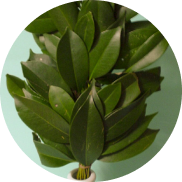
Sakaki
As nature worship is a key element of Shintoism, trees play an important role. Certain types are considered sacred and are known as “shinboku.” Not unlike torii, these trees, which surround a shrine, create a sacred fence inside of which is deemed a purified space. Although there are a few types of trees that are considered sacred, perhaps there is none more important than the sakaki, a flowering evergreen native to Japan. Sakaki trees are commonly found planted around shrines to act as a sacred fence, and a branch of sakaki is sometimes used as an offering to the gods. One of the reasons that sakaki trees are considered sacred in Shinto has to do with the fact that they are evergreens and therefore symbolic of immortality. Another important reason is tied to a legend in which a sakaki tree was decorated in order to lure Amaterasu, the sun goddess, out of her hiding place inside a cave.
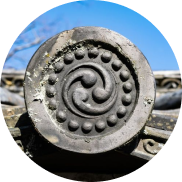
Tomoe
The swirling "tomoe" symbol may remind many of China’s well-known yin-yang symbol. However, the meaning and use are quite different. Tomoe, often translated as “comma,” were commonly used in Japanese badges of authority called “mon,” and as such tomoe are associated with samurai.
Tomoe can feature two, three, or even four commas in their design. The three-comma "mitsu-domoe", however, is the most commonly used in Shintoism and is said to represent the interaction of the three realms of existence: heaven, earth, and the underworld.
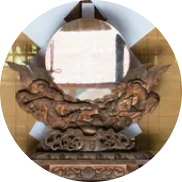
Shinkyo
Shinkyo or "god mirror" is a mystical object said to connect our world to the spirit realm. Shinkyo can be seen displayed at Shinto alters as an avatar of the kami, the idea being that the god will enter the mirror in order to interface with our world. This belief goes all the way back to a legend involving the Japanese sun goddess, Amaterasu, who once went into hiding in a cave, thereby plunging the world into darkness. In order to coax her out of the cave, numerous other gods gathered outside the cave and threw a party. The gods hung jewels and a mirror from a sakaki tree in front of the cave to distract Amaterasu's attention should she venture outside. Curious about the festive noises, Amaterasu peeked out of the cave and asked why the other gods were celebrating. In response, she was told that there was a goddess even more beautiful than herself outside the cave. Upon exiting the cave, she was greeted by the mirror and her own reflection, at which point, the other gods took the opportunity to seal the cave shut with a shimenawa.
This same mirror was later given to Amaterasu's grandson with the instructions to worship it as if it were Amaterasu herself. In this way, one does not necessarily pray to a shinkyo, but rather to the god of that shrine for which the mirror is acting as a physical avatar. The shinkyo is considered a "shintai," or a physical stand-in that the kami can inhabit in the human realm.
By the way, the cave described in the legend is actually a real place, now called the Amanoyasugawara Shrine, in Miyazaki Prefecture.




